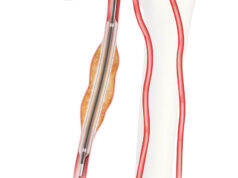To mark the 20-year anniversary of drug-coated balloons, Bruno Scheller (Homburg/Saar, Germany) and Gunnar Tepe (Rosenheim, Germany), talk to Vascular News about their contributions to the birth and evolution of these devices.
Scheller discusses his work in the 1990s with Ulrich Speck (Berlin, Germany) in the field of contrast media and the early use of paclitaxel, noting that, coupled with the contrast medium, it led to a “long-term biological effect”. However, the problem with the contrast media approach was that “it was not really lesion-specific” in relation to local drug delivery.
Data from early animal testing and first clinical trials, using balloons coated with contrast media and paclitaxel, elicited “strong opposition” from the scientific community, says Scheller. Nevertheless, the researchers were convinced about what they were doing and continued to establish high-quality clinical research. Scheller recalls the unblinding of the first-in-man trial, the PACCOCATH-ISR as “an extremely good moment” because it provided proof that the research direction that had been viewed with scepticism and described “crazy” was “exactly the right way”.
Tepe, who also collaborated with Scheller and Speck in the early days of DCBs, talks about some of the difficulties the researchers encountered in gathering support for the idea. He highlights the THUNDER trial–which examined DCB versus plain balloon angioplasty for the treatment of femoropopliteal artery disease–noting that “expectations for success were really low”.
When he saw the first images of the patients who received drug-coated balloons Tepe was “astonished” because “we could see something different here”. Tepe further outlines his experience presenting the data to a packed auditorium, adding that soon “people started to believe” the results and that ultimately “we could prove that these drug-coated balloons were safe and effective in all patients”.
Tepe alludes to the fact that the involvement of Invatec, that was later acquired by Medtronic, was key to transforming the first home-made balloons into devices that could be widely used in patients and backed by long-term level one evidence. “Only with this support”, says Tepe, “we could prove that these drug-coated balloons are safe and effective in all patients”, adding “we could bring something new and something different to the patients”.
This video is sponsored by Medtronic.
Episode 2: Are all peripheral drug-coated balloons created equal?
EPISODE 3: The unique recipe for long-term clinical benefit with IN.PACT™ Admiral™ DCB
Episode 4: Real world data show IN.PACT Admiral DCB is “very efficient” even in complex lesions
COMING SOON
Episode 5: The impact of long-term DCB outcomes on patients’ quality of life
















